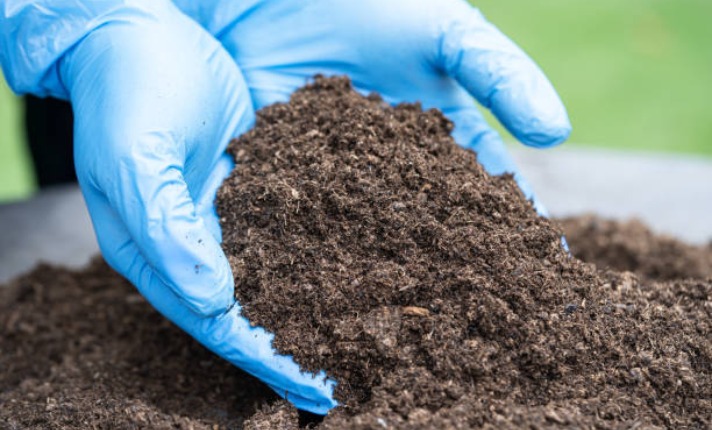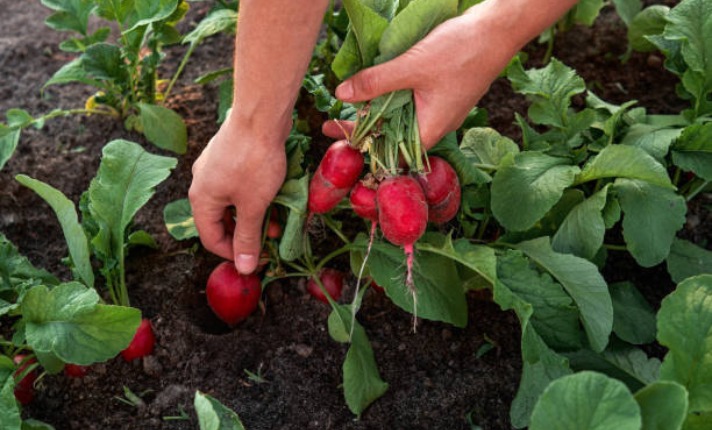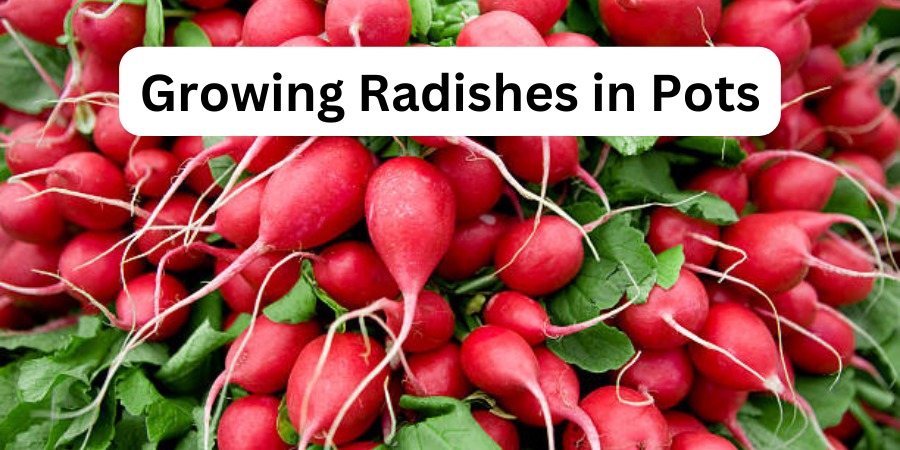Last Updated on October 11, 2024 by Jocelyn
Growing radishes in pots is an ideal way to enjoy fresh Raphanus sativus even if you have limited space. Whether you have a balcony, patio, or a tiny backyard, you can easily grow these peppery veggies. This method is perfect for urban gardeners and those with the smallest spaces.
Radishes are a fast-growing crop, ready to harvest in just a month. Using containers gives you the flexibility to move your plants to catch the best sunlight. You can grow strong, healthy radishes with the right depth and nutrient-dense soil. This makes them a great addition to your kitchen garden.
By following some simple tips, even beginners can grow radishes successfully. They are a delicious addition to salads, pasta, or as a roasted side dish. Start your journey of growing radishes in pots and enjoy the freshest, home-grown produce.

Table of Contents
ToggleCan You Grow Radishes in Containers?
Yes, you can! Growing radishes in containers has several advantages. It allows better control over soil quality and pest management. You can move the containers to find the best location for sunlight and protect them from harsh weather.
Containers also make it easier to manage space, especially in small areas like balconies or windows. This method often leads to a quicker harvest due to the controlled environment.
How to Grow Radishes in a Pot
Container gardening with radishes is an engaging activity! Follow these steps to get started:
- Choose the right container: It can be plastic, terracotta, or rectangular. Make sure it has drainage holes.
- Use well-draining potting soil. Garden soil is not suitable. Mix in some compost for extra nutrients.
- Fill the pot with the soil mix. Ensure it’s at a pH of 7.0 using a test kit.
- Consider a wide or circular pot for more plants. Square ones work too. Six inches deep is enough.
- Plant the radishes between rows. A handful of seeds from Burpee will do. Water them well but don’t overwater.
- Provide enough light. Radishes need fresh air and sunshine.
- Never reuse old soil. Always start with Gold Premium potting soil for best results.
- Watering should be regular but moderate.
- After a few weeks, you’ll see your plants grow. You can even enjoy radishes for breakfast.
Want to increase your container vegetable yield? Read my guides:
- Growing Green Beans in Containers
- How to Grow Lettuce in a Pot
- How to Grow Kale in Containers
- Growing Cabbage in Containers
Picking the Right Container
Radishes grow best in the right container. Choose a pot with drainage holes at the bottom to keep roots from rotting. Clay pots let roots breathe but dry fast. Plastic pots keep moisture well. Wooden containers are sturdy and insulated. Fabric pots are breathable with good drainage.
- Container Size and Depth
Pick a container based on radish varieties. Shallow-rooted radishes like Cherry Belle need only 6 inches of depth. Daikon and Watermelon radishes need larger pots, about 12 inches deep. A 2-3 gallon container works for most radish crops.
- Proper Drainage
Ensure your container has enough drainage to avoid soggy conditions. Drill holes in the bottom if needed. This keeps the soil moist, not soggy. Radishes in poor drainage will rot.
- Container Material
Different materials have unique benefits. Clay is good for airflow but dries fast. Plastic retains water. Wood is sturdy and insulated. Fabric is breathable and drains well. Choose what suits your home and garden’s decor.
- Portable Containers
Portable containers help move radishes to shady spots in the afternoon sun. This protects them from the weather. Light containers are easier to move and shield the plants well.
- Innovative Options
Try innovative container ideas like self-watering or tiered containers. They save space and make watering easy. Vertical containers use less space and get plenty of light.
Choosing the Right Radish Variety
When picking the best radish variety for your container gardening, consider the climate, flavor, and harvest time. Different radishes have unique shapes, colors, and tastes.
Some are ideal for cooler weather, while others do better in warmer seasons. The growing period also varies, with some ready to harvest in just a few weeks and others taking longer.
By understanding these factors, you can select a variety that suits your garden conditions and culinary needs, ensuring a successful and satisfying harvest.
| Radish Variety | Description | Ideal Planting Season | Harvest Time | Taste and Use |
| French Breakfast | Long, slender, crimson top, white tip | Early Spring | A few weeks | Mild flavor, great for salads |
| Cherry Belle | Small, round, bright red skin, crisp white flesh | Spring, Summer | 22-30 days | Crisp and crunchy, perfect for fresh eating |
| Easter Egg | A mild, colorful addition to salads | Spring | 22-30 days | Mildly peppery, and colorful in dishes |
| Miyashige White Daikon | Long, white, mild flavor, used in Japanese cuisine | Fall, Winter | 60 days | Mild, used in cooking and salads |
| Watermelon Radish | Green exterior, bright pink interior, round | Spring, Fall | 60 days | Mildly peppery, colorful in dishes |
| White Icicle | Long, slender, white | Spring, Summer | 30-35 days | Mild, crunchy, good for raw eating and salads |
Planting Radish Seeds in a Pot
Starting your radish garden in pots requires the right location and quality potting soil. Follow these steps to get your radishes growing strong.
- Best Time to Plant Radishes
Plant radishes in early spring or fall for the best results. They prefer cooler temperatures and can even be planted indoors if the ground is too cold.
- Seed Depth and Spacing
Plant seeds at a depth of about half an inch. Leave a couple of inches between each seed to ensure proper spacing and healthy growth. Use a shovel to make small holes for each seed.
- How to Sow Radish Seeds
First, fill your pots with potting soil. Scatter the seeds thinly and cover them with a thin layer of soil. Keep the soil moist but not wet. Ensure they are in a sunny location like a window to help them sprout.
Place the trays near the window for better light. Sow the seeds in rows with proper spacing. Transplant seedlings if they are grown too close. For better growth, keep an eye on the temperature and ensure it stays optimal.
Regular watering and adding nutrients to the soil will keep your radishes healthy. Thin the seedlings if they are too close to avoid competition for nutrients.
Preparing the Perfect Soil Mix
When creating a perfect soil mix for container-grown radishes, make sure the dirt is loose and friable. This helps the roots grow without resistance. Avoid heavy, clay-like soil to prevent stunted or misshapen radish plants.
Include nutrient-rich organic matter like compost or manure to achieve a balanced environment. This provides the right nutrient balance for healthy root development. Avoid soil with high nitrogen content, as it can promote leafy growth over root growth.
The pH level of the soil is crucial. Radishes prefer slightly acidic to neutral pH, between 6.0 and 7.0. Use a pH kit to check the acidity. Adjust if necessary, using lime to raise pH or sulfur to lower it.
Create a quality mix by combining one part coconut coir with one part perlite or sand. This ensures even moisture distribution and prevents excess water accumulation.
When potting radishes, label your containers and place them in a warm, sunny spot. Check the soil moisture consistently, especially in warm conditions. The top inch of soil should feel moist to the touch but not wet. This careful maintenance supports healthy radish growth throughout the growing season.

Caring for Radishes in Pots
Growing radishes in pots is a great way to enjoy fresh veggies. Follow these caring tips to ensure a healthy harvest. These simple steps will help you maintain your radishes in top condition.
| Topic | Tips |
| Regular Watering | Use balanced fertilizer, regular feeding, and nutrient-rich compost. |
| Sunlight and Temperature | Full sun for six hours, temperature above 10°C, provide shade in summer afternoons. |
| Feeding | Thin out seedlings to avoid crowding, and ensure enough space for growth. |
| Thinning Seedlings | Check for holes, and use organic pest control methods. |
| Pest Control | Keep foliage dry, and remove affected parts promptly. |
| Disease Management | Retain moisture, use compost or organic mulch, and keep soil cool. |
| Mulching | Retain moisture, use compost or organic mulch, keep soil cool. |
Harvesting Radishes
Radishes grow quickly. They can be ready in just a few weeks. Daikon radishes might take a bit longer, about 60 days. Tracking when you planted them helps find the optimal harvest window.
When roots begin to flower, they turn woody and tasteless. Check soil moisture often. Pull radishes straight up without digging. Use a fork to gently unearth the small ones. Wait a bit if they seem too young.
The journey to growing vegetables starts with picking the quickest types. Three key signs show they are usable: young, tender, not tough or spicy. When shoulders pop out of the soil, the top of the root should be visible.

Radishes need to be around an inch in diameter before you pull them. You can replant those that aren’t ready to grow more. Remove the tops and greens right away. They are edible and quite tasty. Plan on reducing moisture by brushing off extra dirt. Store them in a cool place, like a refrigerator.
Wrap radishes in a cloth or paper towel before placing them in a perforated plastic bag. This keeps them fresh in the vegetable drawer.
Keep them at 32°F with 95% humidity to store well. Snip the leaves and rinse off the dirt. The tender ones are the sweetest. Avoid those that have split. Radishes can be used in cooking or as a snack. Snip off the tops and enjoy their fresh taste.
FAQ’s
Q: What is the Best Container for Growing Radishes?
A: To grow radishes, use a deep, rectangular pot. It should be 12 inches deep and 12 inches wide. You can also use circular or square containers with the same depth.
Q: What Should Not Be Planted With Radishes and Why?
A: Do not plant radishes with brassicas like cauliflower, broccoli, and cabbage because they hinder radish growth. Avoid hyssop and turnip as they can also harm radishes. Instead, flowering plants can be used to attract beneficial insects and pollinators.
Q: Is Potting Mix Good for Radishes?
A: Yes, potting mix is good for radishes. Use loose, airy soil with perlite and coarse sand for better drainage and to prevent the soil from getting waterlogged. This helps the radish roots grow well.
Q: Where Is the Best Place to Plant Radishes?
A: Radishes grow best in a sunny spot with at least six hours of sun each day. Make sure your pot is in a spot that gets sun and avoid shade. Larger radishes need more energy from the sun.
Q: What Month Is Best to Plant Radishes?
A: The prime month to start sowing radish seeds is April as the soil warms and temperatures rise. September is also ideal after the heat mellows from summer, making it perfect for planting before the cold winter.
Conclusion
Growing radishes in pots is a fulfilling activity. It offers fresh, healthy produce and the joy of cultivating your own food. Watching your efforts transform into a bountiful harvest of crisp, delicious radishes provides immense satisfaction.
Radishes grow well in small spaces and different micro-environments, making them perfect for containers on your balcony or patio. By ensuring they receive adequate sunlight and moisture, you can achieve a plentiful harvest. This gratifying gardening experience connects you to nature and allows you to enjoy fresh, homegrown veggies.

